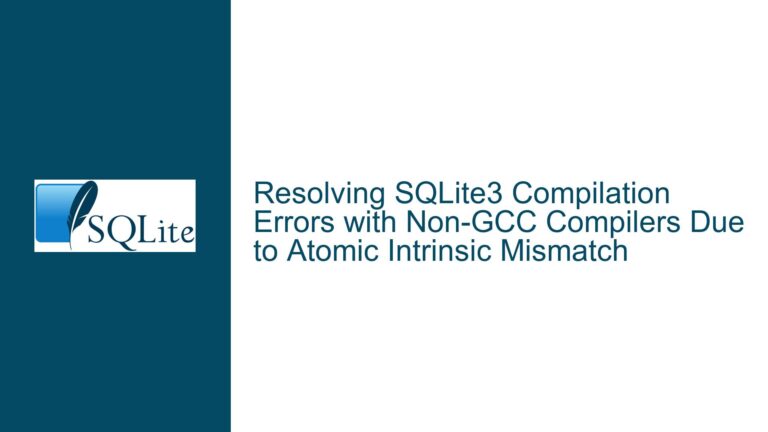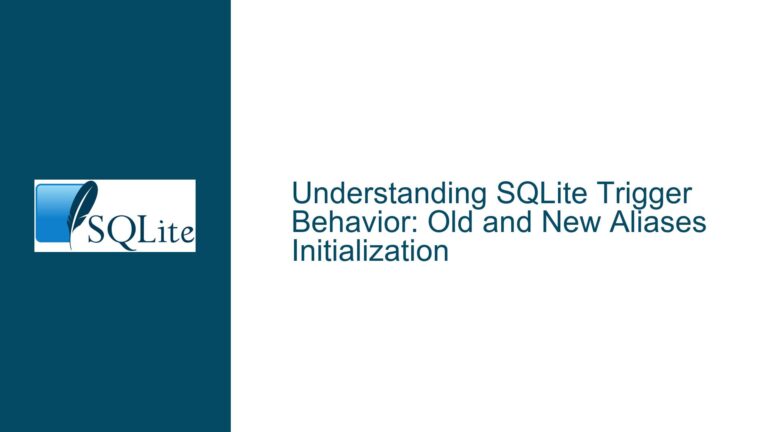Nesting SQLite SELECT and UPDATE Statements: Risks and Best Practices
SQLite API Misuse and Transaction Management in Nested Queries
When working with SQLite at the C API level, one of the most common pitfalls is the improper nesting of SELECT and UPDATE statements. This issue arises when developers attempt to interleave UPDATE operations within a SELECT loop, often due to complex business logic that cannot be easily expressed in pure SQL. While this approach might seem intuitive, it introduces significant risks, including API misuse, transaction management errors, and unpredictable behavior in data integrity.
The core problem lies in how SQLite handles transactions and isolation levels. When a SELECT statement is executed, SQLite implicitly starts a read transaction. If an UPDATE statement is then executed within the same connection, the transaction is upgraded to a write transaction. This upgrade can lead to SQLITE_BUSY errors if another connection is concurrently accessing the database. Even worse, interleaving SELECT and UPDATE operations on the same table can result in skipped rows, infinite loops, or inconsistent data due to changes in the underlying index structure during the scan.
To mitigate these risks, SQLite provides mechanisms such as immediate transactions (BEGIN IMMEDIATE) to avoid SQLITE_BUSY errors. However, this does not address the fundamental issue of data consistency when updating rows during a scan. The lack of explicit support for features like "SELECT … FOR UPDATE" or "UPDATE … WHERE CURRENT OF CURSOR" in SQLite further complicates matters, as these constructs are commonly used in other databases to safely perform interleaved updates.
Understanding the nuances of SQLite’s transaction model is crucial. Each call to sqlite3_step() on a SELECT statement creates a transaction, which remains open until the SELECT completes. If an UPDATE is executed within this transaction, the transaction is upgraded to a write transaction, but this does not guarantee isolation from other connections. Moreover, the absence of multi-version concurrency control (MVCC) in SQLite means that changes made by one connection are immediately visible to others, increasing the risk of conflicts and data anomalies.
Interleaved SELECT and UPDATE Operations Leading to Data Corruption
The primary cause of issues in nested SELECT and UPDATE operations is the lack of isolation between statements within the same connection. Unlike client-server databases, where the server manages query execution and result buffering, SQLite operates directly on the database file. This design choice, while efficient, means that changes made by one statement can immediately affect the results of another statement, even within the same connection.
For example, consider a scenario where a SELECT statement is scanning a table using an index. If an UPDATE statement modifies the columns used in the index, the position of the updated row within the index may change. This can cause the SELECT statement to skip rows or process the same row multiple times, leading to unpredictable results. In extreme cases, this behavior can result in infinite loops or data corruption.
Another common issue arises from the misuse of the SQLite C API. Functions like sqlite3_exec() or custom helper functions (e.g., sqlite3_execf) that prepare and execute statements within a loop can lead to performance degradation and increased risk of errors. Each call to sqlite3_prepare_v2() and sqlite3_step() incurs overhead, and repeatedly preparing the same statement within a loop is inefficient. Additionally, failing to check the return status of each API call can result in undetected errors, further exacerbating the problem.
The absence of explicit documentation on these pitfalls in the SQLite manual is a significant gap. While experienced developers may recognize the risks, those new to SQLite or transitioning from other databases may inadvertently introduce bugs. The lack of built-in mechanisms to detect and prevent such misuse, even when SQLITE_ENABLE_API_ARMOR is enabled, further compounds the issue.
Implementing Safe Patterns for Nested SELECT and UPDATE Operations
To address the challenges of nested SELECT and UPDATE operations in SQLite, developers should adopt safe patterns that ensure data consistency and avoid API misuse. One effective approach is to separate the SELECT and UPDATE phases into distinct transactions. This can be achieved by first collecting the necessary data into a temporary table or in-memory structure, then performing the updates in a subsequent transaction.
For example, instead of interleaving SELECT and UPDATE statements, the following pattern can be used:
- Execute a SELECT statement to retrieve the required rows and store the results in a temporary table or an in-memory array.
- Iterate over the collected data and perform any necessary business logic.
- Execute the UPDATE statements based on the processed data.
This approach ensures that the SELECT operation is completed before any updates are applied, eliminating the risk of index corruption or inconsistent results. Additionally, it allows for better error handling and recovery, as the update phase can be retried independently if necessary.
Another best practice is to use prepared statements efficiently. Rather than preparing the same UPDATE statement repeatedly within a loop, prepare the statement once before the loop and use sqlite3_bind() and sqlite3_step() to execute it with different parameters. This reduces overhead and minimizes the risk of errors.
For complex business logic that cannot be expressed in SQL, consider using SQLite’s extension mechanisms, such as user-defined functions (UDFs) or virtual tables. These features allow developers to implement custom logic in C or other languages while maintaining the benefits of SQLite’s lightweight design.
Finally, always use explicit transactions and proper error handling. Begin transactions with BEGIN IMMEDIATE to avoid SQLITE_BUSY errors, and ensure that all API calls are checked for errors. Use sqlite3_finalize() to clean up prepared statements and sqlite3_close() to release database connections properly.
By following these best practices, developers can avoid the pitfalls of nested SELECT and UPDATE operations in SQLite and build robust, efficient applications. While SQLite’s simplicity and performance make it an excellent choice for embedded systems and lightweight applications, understanding its limitations and adopting safe patterns is essential for maintaining data integrity and reliability.






